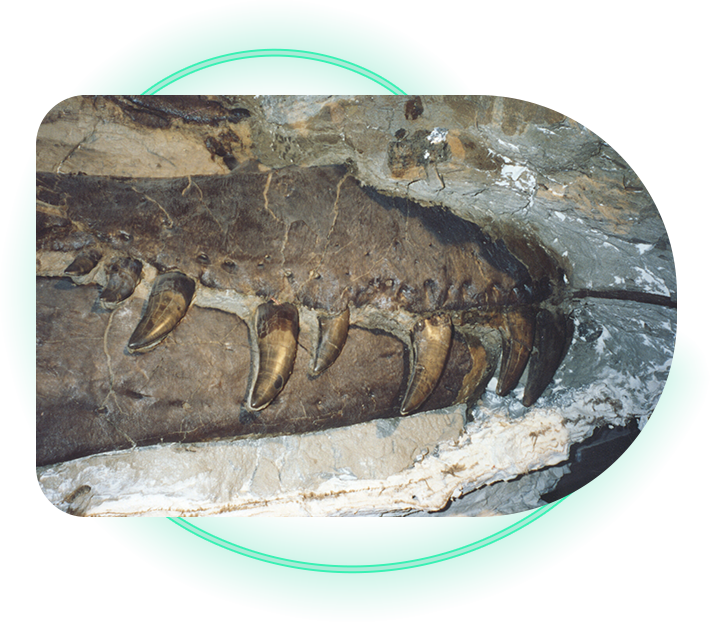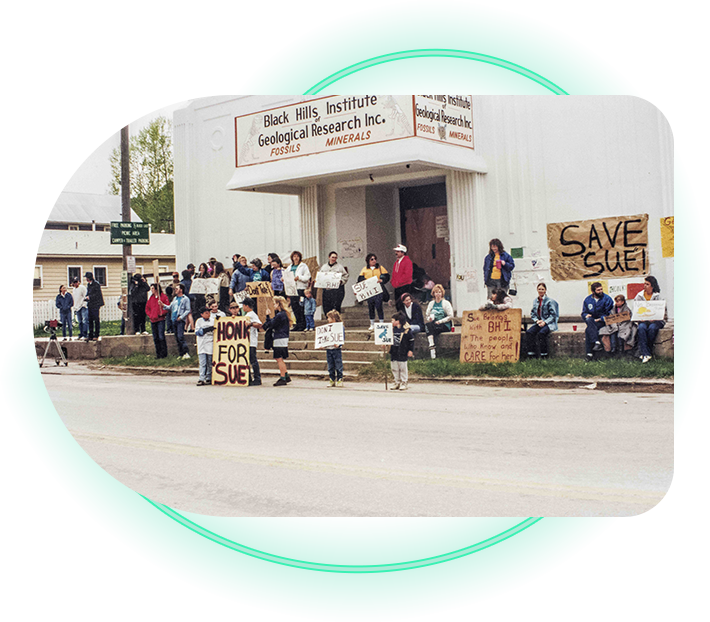Favorite CollLection Triceratops Real Figure Keyring
$11.95
The following pages give a short history of the T.rex, named SUE, by
the people directly involved in her excavation, initial preparation,
and ownership.
This first installment (spread over three pages) follows SUE from her
discovery and excavation through her initial preparation. The
second half finds SUE the object of a raid and seizure, a court case,
and, eventually, an auction.

Ten years ago, SUE, the Tyrannosaurus rex skeleton of so much acclaim, laid buried near the bottom of a large hill in north central South Dakota. She had remained entombed and unnoticed, since her death approximately sixty-five million years ago.
During her lifetime, she must have been a real terror! She stood over twelve feet high at the hips, more than forty-one feet long, and had a skull more than five feet in length with sockets for fifty-eight teeth. Some of these teeth protruded more than six inches out of the skull! She was an old animal (no one knows how old), with a beat up, sore, heavily damaged body. She had been through a lifetime of scrapes and battles and had always come out a winner, until the day she laid down and died in a stream that helped preserve her body in a most remarkable fashion. There she, and all her secrets remained buried until August 12, 1990, when Susan Hendrickson discovered her weathering out near the base of a fifty foot cliff.
Sue was a volunteer with the Black Hills Institute of Geological Research. She had first met my brother, Pete Larson during a trip to Peru in 1985 with Kirby Siber, founder of the Saurier Museum in Switzerland. Sue and Pete became very close during that trip, and Sue later moved to Hill City to be with Pete. She became actively involved with many of the excavations Pete undertook. Although her work took her all over the world buying and collecting amber, pearls, minerals, ammonites, and other items, she never lost her passion for archeological digs or for her paleontological excavations with Pete and the Institute.
Since 1979, the Black Hills Institute operated a dinosaur quarry north of Faith, South Dakota on the Ruth Mason Ranch. There, we excavated the partial remains of hundreds of disarticulated Edmontosaurus annectens (duckbill dinosaur) skeletons.
The Ruth Mason Dinosaur Quarry experience taught BHIGR staff the means to collect bones quickly, efficiently, and without damage. It was at the quarry too, that early mapping techniques were acquired. Institute staff collected all associated fossils at the site, as well, including leaves, amber, wood, invertebrates, and micro vertebrates. From this information, we were able to put together an excellent picture of the paleo environment at the Ruth Mason Quarry. We realized early on, the importance of preserving information about all the fauna at this and every site where we would collect.
At the Ruth Mason Quarry, we had a unique approach to paleontological digging. We allowed interested people (volunteers) from all walks of life, the opportunity to learn proper digging procedures and the Institute’s innovative techniques for free!
During this time, a crew from the University of Wisconsin, Madison, led by Klaus Westphal, came to learn and to help excavate bones at the site. The Madison group worked with us for three years. We then gave them enough bones to mount the largest Edmontosaurus skeleton on display to date. It was through our association with Westphal’s clan that we first met Terry Wentz, a volunteer with the group, who later became SUE’s chief preparator.
We also hosted groups from the Memphis Pink Palace Museum, the University of Kansas, the New Mexico Bureau of Mines, the Denver Museum, the Yale Peabody Museum, Kirby Siber and his crew from Switzerland, and from numerous rock and fossil clubs.
Walter Cronkite and his photo crew visited, and did a segment for a series he hosted called “Dinosaur, The Biggest Story Ever Told”.
We also allowed hundreds of individual volunteers to participate in the experience of a lifetime – digging dinosaur bones! The Ruth Mason Quarry was an ideal opportunity for future paleontologists to hone their digging and field preparation skills under the guidance of the very experienced Black Hills Institute staff.

In July, 1990, we went back to the Ruth Mason dinosaur dig for our annual four to six week digging season. After setting up our camp, we set out toward the dig and found a dead horse on the property.
Over the next several days, we checked with the neighboring land owners, attempting to notify the owner of the status of the horse. Maurice Williams, a neighbor who was missing a horse, came over and identified this one as belonging to him.
Maurice visited us at the Mason Quarry and became very interested in what we were doing. He told us he owned a lot of land and had numerous “badlands-like” outcrops on his property. He invited us to come to his property and prospect for fossils. We told Maurice that if we found anything, we could give him some money for it. He said he would be happy just to have someone look on the place to see what they could find.